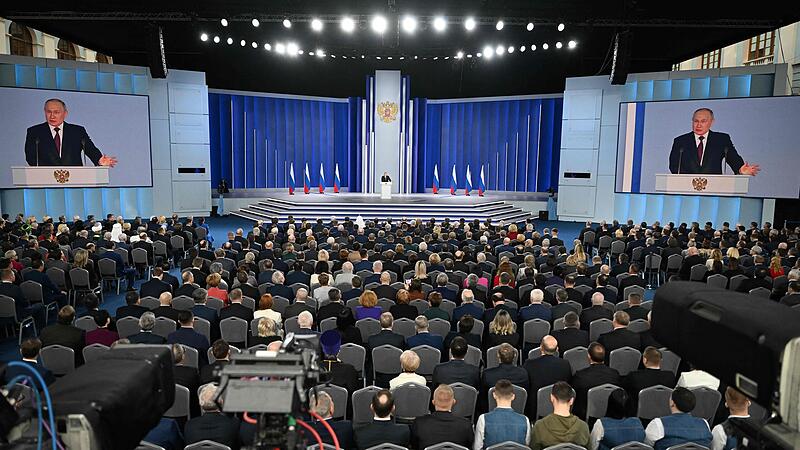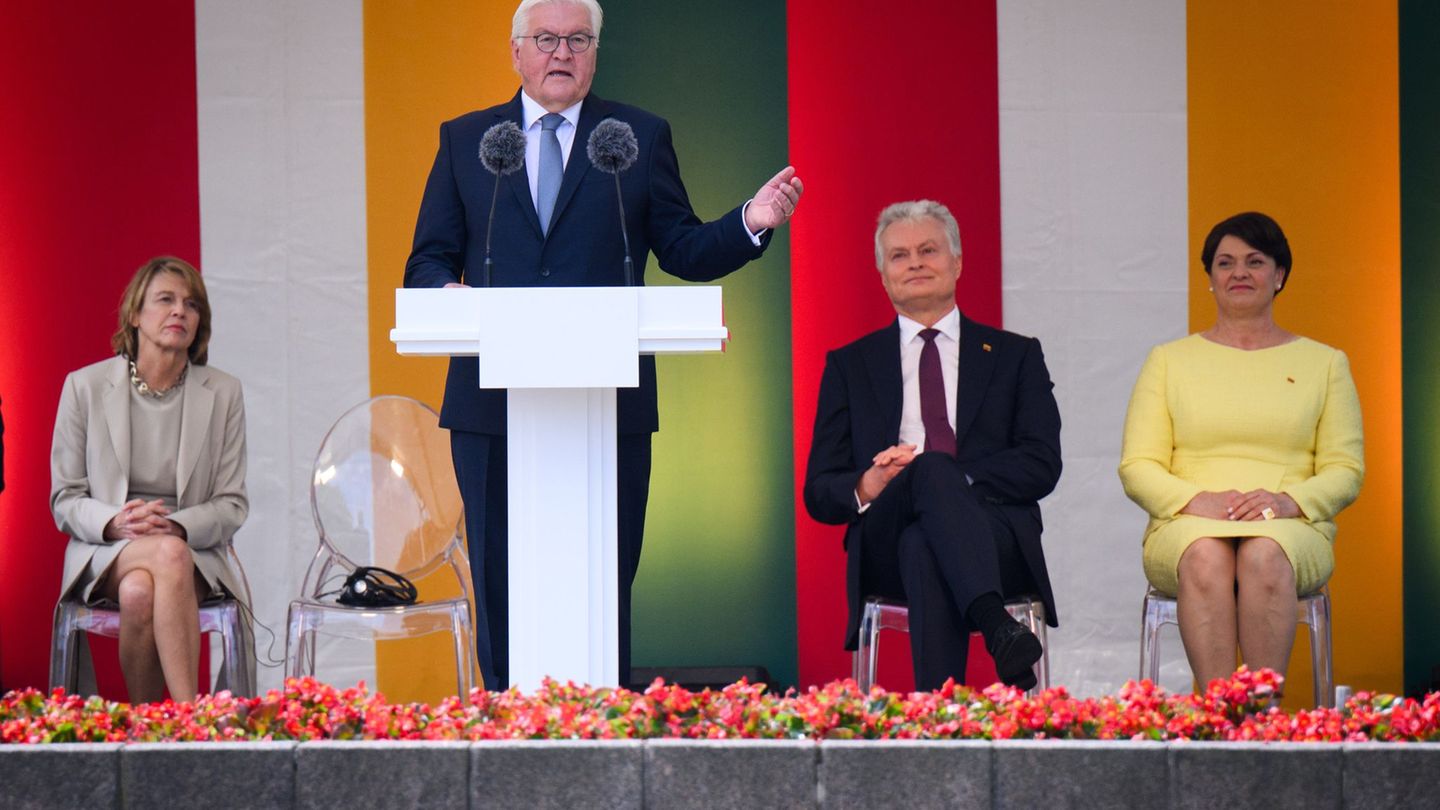Image: APA/AFP/SPUTNIK/PAVEL BEDNYAKOV
At the same time, according to the text of the speech published in Russian, he said: “This project dates back to the XIX century. It was in Austria-Hungary, in Poland and elsewhere with one goal – to rip these historical areas, which are now called Ukraine, out of our country .”
The statement caused international malice because there had never been a Polish state in the entire 19th century. The three divisions of the territory of Poland-Lithuania – still one of the largest European states in terms of area in the mid-17th century – during the 18th century (1772, 1793 and 1795) resulted in the disappearance of a sovereign state of Poland. The territories had been divided among Prussia, the Habsburg Empire and the Russian Tsarist Empire, with Russia getting more than half of the territory. After the Congress of Vienna in 1815, there was again a “Kingdom of Poland” with Warsaw as its capital, but it was ruled by the Russian tsar. In 1867 the area was also officially annexed by Russia.
The “Kingdom of Galicia and Lodomeria”
The areas occupied by the Habsburg Empire in 1772, which today include parts of south-eastern Poland and western Ukraine, were annexed to the Austrian Empire in 1804 under the name “Kingdom of Galicia and Lodomeria”. The name is based on Latinized forms of the medieval principalities of Halych and Volodymyr. Other areas of Poland, which came to Austria in the course of the third partition of Poland, were largely lost again in the course of the Napoleonic Wars.
Galicia was a multilingual area inhabited by Poles, Ukrainians (called Ruthenians in the Habsburg Empire), and German speakers, including a fairly high proportion of Yiddish-speaking Jews. The Slavic population was Catholic throughout, with the Ukrainian speakers belonging to the Greek Catholic Church following the Union of Brest in 1596. The region was very poor and almost exclusively agricultural, with Polish landowners forming the upper class.
No connection to Russia
From the 19th century onwards, a Ukrainian national movement arose in Galicia, whose representatives, in view of the dominance of the Polish-speaking elite, strove to found their own Ukrainian-speaking crown land in the east of the region. Loyalty to Vienna was strong in these circles, and secession from the Habsburg Empire or even annexation to Russia was by no means the goal. Nevertheless, the state leadership in Vienna preferred the Poles; In 1866 Polish became the official language in Galicia, which subsequently received extensive autonomy. The disputes between the Poles and the Ukrainians shaped the further development of the economically backward area, which was characterized by strong emigration, until the end of the Habsburg monarchy in 1918.
Another region of the Danube Monarchy with a significant Ukrainian population was Bukovina, ceded to Vienna by the Ottoman Empire in 1775. Today the north of the former crown land belongs to Ukraine, the south to Romania. In addition, there was a significant Ruthenian (also Rusinian) population in the northeast of the Kingdom of Hungary, which was also under the rule of the Habsburgs. These areas became part of Czechoslovakia after World War I and are now part of Ukraine.
Ukrainian national feeling
In the First World War, when Austria-Hungary and Russia fought each other, Ukrainian national sentiment was of course systematically used as a “weapon” on both sides. The two opposing power blocs deliberately fueled Ukrainian nationalism in the opposing camp in order to weaken it, said the Lviv historian Jaroslaw Hrystak in a 2014 APA interview on the 100th anniversary of the outbreak of war. “Austria-Hungary and Germany played against Russia on the national card, since the Ukrainians were the second largest ethnic group in the Russian Empire, and Russia on the so-called ‘Russophile movement’ in the Austro-Hungarian Empire,” explains the historian. “In this war, Ukrainian nationalism was the laughing third party.”
In fact, in the last year of the war, the independent Ukrainian People’s Republic emerged in the territory of Ukraine belonging to Russia, which was temporarily renamed the “Ukrainian State” after the intervention of the Central Powers. In turn, the West Ukrainian Republic was founded in the Ukrainian-speaking areas of the Danube Monarchy at the end of 1918, which united with the restored People’s Republic in 1919. These short-lived formations were the first Ukrainian nation-states in the modern sense. However, they soon merged into the Ukrainian Soviet Socialist Republic.
“An existential threat to Russia”
For Putin, history determines today’s political decisions, US historian and lawyer William Partlett writes in an article for the US journal Perspectives on History: “Putin regularly describes the invasion of Ukraine as a technical decision made by history is demanded. In his account, history proves that Russia and Ukraine have been one ‘from time immemorial’. A separate Ukrainian identity separate from Russia must therefore have come from outside manipulation and represents an existential threat to Russia,” analyzes the professor at the Australian University of Melbourne.
The US historian Faith Hillis describes the historical and intellectual background of Putin’s statements: “What we know today as Ukraine and Russia began in Ukraine, in the city of Kiev. (This refers to the ancient Slavic empire of Kievan Rus in the Middle Ages, note.) (…) They had a common religion, at times a common language, common ideas. But starting in the 19th century, some Russian intellectuals began to see this topic through the lens of Slavophilia,” she explains in an interview with the Russian exile medium “Meduza”. In the Slavophile view, “Russians, Ukrainians and Belarusians belonged to a large slavic nation. (…) However, the Russians are at the top, they are culturally superior, the Ukrainians and Belarusians are ‘peasant peoples’,” said the professor of Russian history from the University of Chicago.
Psychologically, however, Putin’s attitude, his “anger,” was more shaped by Russia’s economic and social collapse after the collapse of the Soviet Union in 1991, she analyzed. “We will show the world who’s boss and we will also show Ukraine who’s boss.” Their conclusion: “Putin is not trying to restore the Soviet Union as an ideological state. He is trying to restore the Russian Empire.”
Source: Nachrichten




